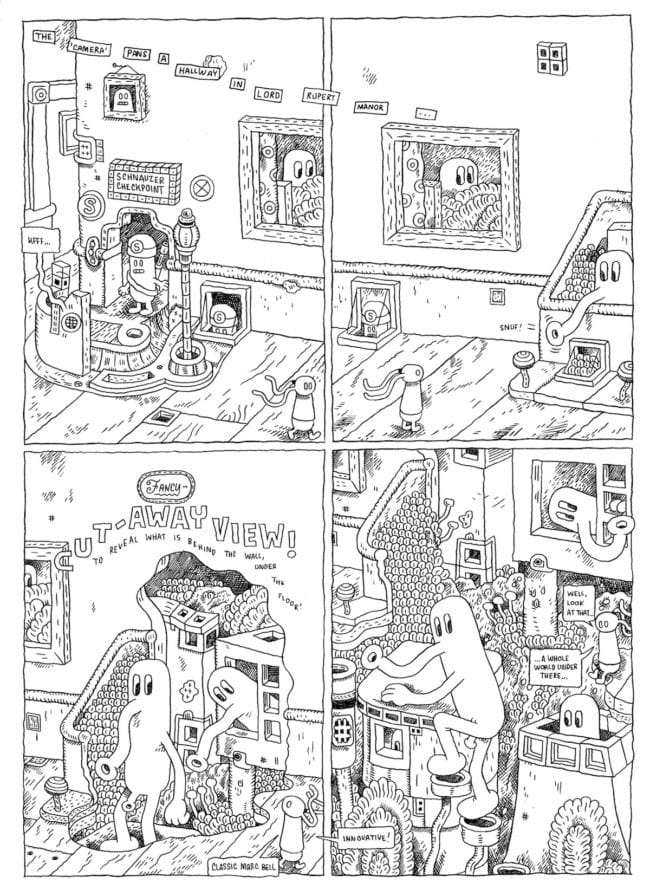A 15-year gap between issues? This might be a world record. But a new infusion of comics by Marc Bell is a gift to us all. In the interim, Bell has released the graphic novella Stroppy, two anthologies of various comics and fine art (Hot Potatoe, Pure Pajamas) and has been a contributor to Sammy Harkam’s Kramer’s Ergot, that annual tome of cutting-edge comics. He has also done recurring strips for Canadian weekly newspapers.
Marc Bell’s work stays with you. It is disarmingly funny, random, bleak and touching. It doesn’t explain itself or make a concerted effort to shepherd your attention. Its visuals suggest Crumb, Basil Wolverton, vintage black-and-white animated cartoons and off-brand funny animal comics. Bell’s work is also akin to the techniques of early newspaper cartoonists and to the artists of Harvey Kurtzman’s original Mad comic book. Visual information is everywhere on Bell’s pages. It clutters the corners, careens along the margins of its panels and often creates narratives within narratives. It’s compulsively readable and re-readable.
The pool of Marc Bell is all deep end, so the second Worn Tuff Elbow is a fine place to dive in if you’re new to his work. Though I’m saddened that “Wilder Hobson’s Theatre Absurd-O” is not continued from the 2004 issue, I realize that a creator’s priorities can change over time. Bell does return to a theme that has dominated his comics in the past decade—the pulverization of humble, street-level life by the wealthy and by corporate entities. In Bell’s amorphous world, which reminds me, at times, of the shape-shifting atmosphere of the early talkie Fleischer cartoons, dear hearts and gentle people are steamrollered by mysterious enterprises—The All-Star Schnauzer Band, whatever they may be, seems bent to acquire every scrap of real estate in this world, while blundering, invasive and clueless Monsieur Moustache tramples the world around him with arrogance.
This theme is a fulcrum of Marc Bell’s storytelling. It is one of comics’ most acute depictions of the end of a way of being that anyone born before 1990 can understand. The denizens of Bell’s funky underworld still cling to their old-fashioned ways, but they’re being paved over by the Schnauzers and their ilk—edged out of a comfortable, simple life that doesn’t take up much space or require many resources. As we see charming old neighborhoods bulldozed for soul-less, ugly “modern living environments,” Bell’s message, encoded in the antics of his hand-drawn world, achieves a rare poignance without being preachy or heavy-handed.
Bell’s cartooning is in top form here. He was skilled when his first comics saw print in the 1990s, and he’s gotten better over time. His freehand pen line looks casual but is elegantly designed and achieved. His drawings have great appeal and each panel is a thing of cracked beauty.
WTE 2 begins in stark black and white and contains the sad breakup of his beloved characters Shrimpy and Paul. Color seeps into the book and we’re in the 21st-century milieu of “Bologna Buffet,” which introduces vaping and social media to the Marc Bell universe. Bell’s casual narratives explore the grey areas of life and imagination that many cartoonists avoid.
Bell is a comedian and social satirist with a flair for the absurd that recalls past masters such as Boody Rogers and Cecil Jensen. His best comics make you think and invite re-reading. Stray lines from Bell’s comics pop in my head, and his images are haunting. His work is a powerful reminder that comical comics are always the best—especially when they’re laced with bittersweet and inexplicable moments. I hope we’ll see another Worn Tuff Elbow—or whatever Bell chooses to create—sometime sooner than 2034.










